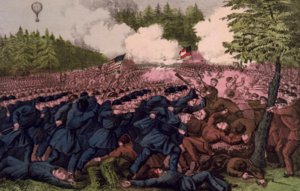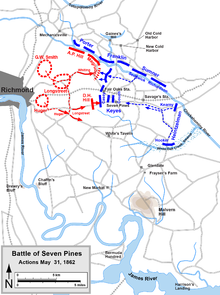Battle of Seven Pines
Battle of Seven Pines / Fair Oaks
Part of: American Civil War

Battle of Seven Pines or Fair Oaks by Currier & Ives
Peninsula Campaign
Hampton Roads - Yorktown - Williamsburg - Elthams Landing - Drewrys Bluff - Hanover Courthouse - Seven Pines - Oak Grove - Beaver Dam Creek - Gaines' Mill - Garnetts & Goldings Farm - Savage's Station - White Oak Swamp - Glendale - Malvern Hill
The Battle of Seven Pines, also called the Battle of Fair Oaks, took place on May 31 and June 1, 1862, during the Union Peninsular Campaign of the American Civil War.
On May 31, the Confederate Army of Northern Virginia under General Joseph E. Johnston attacked the IV Corps of the Army of the Potomac, which had moved into position south of the Chickahominy. Heavy rains the day before had made the small river impassable, so Johnston hoped to beat the southern wing of the opposing army before reinforcements could arrive from the northern bank.
Due to coordination problems, the Confederate attack did not begin until about 3:00 PM. They managed to push the U.S. troops back a bit. A counterattack by the III Corps and by John Sedgwick's division, which had managed to cross the river, stopped the attack. By nightfall the fighting ended in a draw. The next morning the attack was renewed. However, due to errors in leadership Major General James Longstreet's attack was also unsuccessful.
Among the casualties of the first day of fighting was General Johnston, who, seriously wounded, was forced to turn over command to Major General Gustavus Woodson Smith. The latter led the army for less than a day, however, as President Davis appointed General Robert E. Lee as the new commander-in-chief of the Army of Northern Virginia.
Lee eventually broke off the battle after further attacks were repulsed by the now-reinforced Union forces. He moved the Northern Virginia Army to the defensive line around Richmond, Virginia. Lee took advantage of the time and reorganized the army. At the same time, he continued to expand Richmond's defenses, reinforcing to his opponents that he was justly nicknamed the King of Spades. On June 25, he faced McClellan at the Battle of Oak Grove, whom he attacked every day for the next several days during the Seven Days Battle, eventually forcing him to withdraw from the Virginia Peninsula. He only managed a victory over McClellan once, however.
The appointment of the exceptionally capable and courageous Lee as commander-in-chief of the Army of Northern Virginia not only earned the Confederacy a successful repulse of the attack on the Virginia Peninsula, but also strategic opportunities later in the war that significantly affected the duration of the war and could have even led to Confederate victory.

Sketch of the Battle of Seven Pines
Search within the encyclopedia